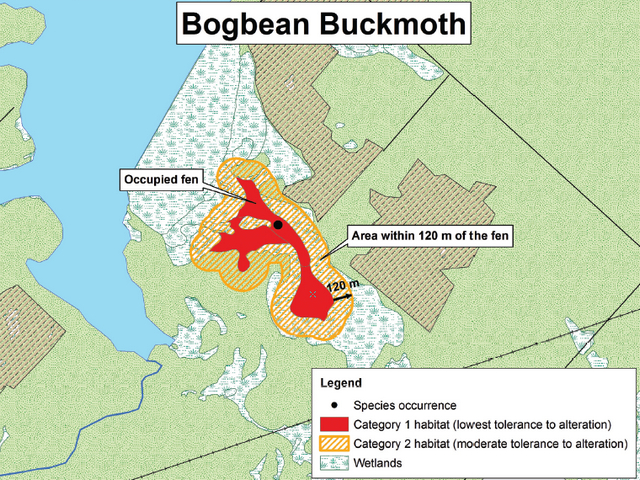Bogbean Buckmoth Habitat Protection Summary
This document provides a brief description of the area that is protected as habitat for the bogbean buckmoth through a habitat regulation under the Endangered Species Act.
The Bogbean Buckmoth is a globally rare moth known to occur only in wetlands in New York State and near Ottawa, Ontario. The species is restricted to open fens containing large amounts of its main foodplant, Bogbean. Adults are medium to large in size, and black with wide, white wing bands. The species was assessed by the Committee on the Status of Species at Risk in Ontario (COSSARO) and listed as endangered on September 28, 2010 due to its habitat specificity and extremely limited geographic range. More information about the species' status can be found at: Bogbean Buckmoth
The habitat regulation for Bogbean Buckmoth protects the extent of the fen where the species is found, and the area within 120 metres of that fen site. These areas are protected until three consecutive years of documented non-use, as long as the habitat remains suitable.
The regulation applies where the species is found in the geographic townships of Goulbourn and Marlborough, near Ottawa, the geographic township of McNab in Renfrew County, and the geographic township of Pakenham in Lanark County.
Supporting rationale
- Bogbean Buckmoth is restricted to fen habitats due to its dependence on Bogbean and sensitivity to movement barriers, such as trees.
- Fen habitats are vulnerable to degradation from non-natural water level fluctuations, invasive plant species and pollution. Protecting the area within 120 metres of the occupied fen will reduce these effects.
- The three-year term allows sufficient time to determine that the site in no longer being used.
Activities in Bogbean Buckmoth habitat
Activities in regulated habitat can continue as long as the function of these areas is maintained and individuals of the species are not killed, harmed, or harassed.
Generally compatible:
- Continuation of non-intensive pasturing or agricultural practices in the area within 120 metres of a protected fen.
- Spot treatments with herbicides or pesticides in the area within 120 metres of a protected fen.
- Pruning of shrubs or trees for maintenance purposes in the area within 120 metres of a protected fen.
- Non-motorized vehicle use of existing recreational trails.
Generally not compatiblefootnote 1 :
- Broad-scale application of road salt, fertilizers, and herbicides or pesticides.
- Alteration of wetland vegetation or water levels, or the removal of peat.
- Construction of houses, other structures, or roads.
- Use of ATVs or snowmobiles in protected fen habitat.
Key terms
Fen: A fen is a type of wetland that accumulates peat. Fens are located in areas where mineralized groundwater discharges to the surface. Water pH is slightly acidic to neutral. Typical fen vegetation includes sedges and mosses, grasses, reeds, low shrubs, and sometimes a sparse layer of tamarack and white cedar. Fen communities are defined according to the Ecological Land Classification (ELC) for Southern Ontario: First Approximation and its Application, dated September, 1998 and published by the Ontario Ministry of Natural Resources.
Below you will find an example diagram of how this regulation would be applied to protect habitat for this species. It indicates how the protected habitat has been categorized, based on how the species uses the habitat and how much activity or change can occur within the habitat, as per the policy "Categorizing and Protecting Habitat Under the Endangered Species Act". This policy can be found at: www.ontario.ca/document/categorizing-and-protecting-habitat-under-endangered-species-act
Sample application of the Habitat Regulation:
Figure 1: Sample application of the habitat regulation for Bogbean Buckmoth

Enlarge Figure 1: Sample application of the habitat regulation for Bogbean Buckmoth
The content of this summary is provided for convenience only. For accurate reference and the most recent version of the regulation, please view Ontario Regulation 832/21 on e-Laws
Footnotes
- footnote[1] Back to paragraph If you are considering an activity that may not be compatible with regulated habitat, please contact your local MNR office for more information and/or to discuss ESA authorization options.